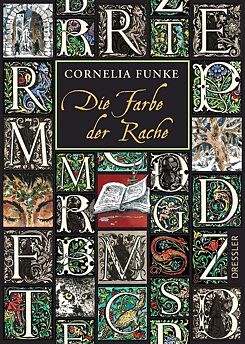Cherrypicker | Literature
For which there are no words
16 years after the final novel in the Inkheart series was published, the author and illustrator Cornelia Funke has embarked on another foray into the world of Meggie, Dustfinger and co. And created a captivating sequel in which the written word is no longer the focus.
By Natascha Holstein
What is more powerful – words or pictures? That is the question around which the fourth book in the Inkheart series, The Colour of Revenge (Die Farbe der Rache), revolves. 16 years after Inkdeath, which was long believed to be the final book of a trilogy, Cornelia Funke is now inviting us back into the world behind the printer’s ink and paper. Unlike in the first three books, however, in which just a select few have the ability to read people into and out of books, it is now the pictures that take centre stage.
A familiar cast
We are reunited with well-known characters from the Inkworld: Meggie and Mortimer, Elinor, Resa, Farid, the Black Prince, Dustfinger. Not to mention Orpheus, who was already notorious for his deceptive and manipulative behaviour in the previous stories. As a child, he had been a fan of Inkheart, the eponymous novel that is the main focus of the first story in the series. And of the characters in it, the evil Capricorn and Basta, and particularly Dustfinger the fire-eater, who Mortimer read out of the book into the “real” world in the first part. He spent years trying to find a way back into his book, and when Orpheus then read him back into the Inkworld he expected his favourite character to be grateful – but he was wrong. Angry and disappointed, he makes contact in the latest instalment with a shadow reader who casts a grey spell. Orpheus has all the characters he does not like – which essentially are all those that readers of the first three novels have grown fond of – banished by an illustrator onto paper and painted over in a special grey shade to make them disappear.Dustfinger, whose beloved wife and daughter are now nothing but grey images in a book, attempts to rescue them. He fails, however, and finds that a spell has also been cast over him. Finally the Black Prince, with the assistance of others such as the plant whisperer Lilia, comes hurrying to his aid and helps him fight Orpheus and bring back those who had disappeared.
A new old story
It is fair to describe the decision to continue a popular series of young adult fiction more than a decade later as bold. And yet Cornelia Funke, in The Colour of Revenge, follows up on the previous story almost seamlessly – albeit five years later. The book features an interview with her in which she explains what prompted her to revisit the Inkworld, saying that she is never able to predict whether a story has really come to an end. Other reasons why she decided to write this sequel are: “ … the fact that Orpheus escaped last time, even though I really had a darker fate in mind for him; my work as an illustrator and the question of whether pictures are more powerful than words, and my love of the Black Prince.”After just a few pages, the reader is quickly transported back into the Inkworld with its glass men and fire elves and its mediaeval atmosphere. The main characters may be different, both familiar and unfamiliar, but that only serves to open up the story even further. The author also addresses social issues such as racism and queerness without this seeming artificial or stilted. For the first time, the reader also learns the names of the main characters – Dustfinger and the Black Prince – who are actually called Nardo and Nyame. Lilia is a new addition who, with her courage and her novel and vibrant kind of plant magic, becomes one of the story’s heroines.
Still breathtaking
Despite the latest book’s somewhat different focus, Cornelia Funke does not introduce an entirely new logic to the popular Inkheart series, though The Colour of Revenge already sets itself apart from the other stories by its title alone. All the same, fans of the series will find it a welcome return to this breathtaking world, and one that is also a shorter and more entertaining read than the very long third novel.It is presumably up to the reader to decide, after reading all four novels, whether words or pictures are more powerful. Ayesha, a young woman who was held captive by the evil shadow reader and then joins forces with Dustfinger’s friends, declares at the end: “Pictures say more than words, don’t you think? After all, they also know about things for which there are no words.”
Cornelia Funke: Die Farbe der Rache (Tintenwelt 4)
Hamburg: Dressler, 2023. 352 p.
ISBN: 978-3-7513-0007-0 (from 14 years)
You can find this title in our eLibrary Onleihe.
